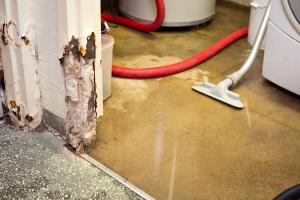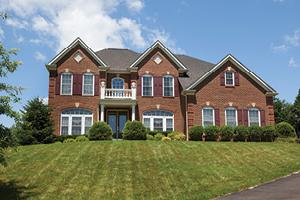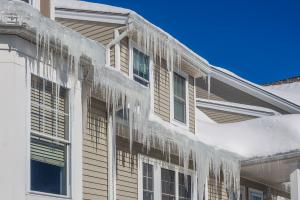Putting the plug in water damage

After a heavy storm or a burst pipe homeowners could often be left looking at puddles in their basement and wondering what to do next. In fact, 98% of basements in the U.S. will experience water damage at some point. Here are some steps to avoid water damage, tips on how to spot a potential issue and the insurance coverage you need to protect your home.
How to prevent water damage:
- Be aware of where you plant. If you have flowers or any type of vegetation close to your home it can attract water seeping directly into your home. Planting at least 12-18 inches away is the best method to prevent water damage.
- Clean out roof gutters. Clogged gutters can leak water into your home’s foundation.
- Keep an eye on your water bill. If your monthly water bill begins to increase this could be a sign of a leak that you aren’t aware of.
- Visually inspect sinks, pipes, drains, washing machines and your water heater on a regular basis for damage or leaks.
- Never pour grease down your sink. Grease compiles and clings to the pipes which could damage or cause blockage.
Indications you might have water damage:
- Stains and discoloring ─ Stains and discoloring in ceilings are the most obvious sign. However, stained rugs and floors on lower levels are indicators as well.
- Water accumulation ─ Standing or pooling water are the most obvious examples of this. Water accumulation usually results from old or malfunctioning appliances like washers, water heaters and toilets. However, a leaking roof and drainage pipes on the outside of your home could cause this as well, especially during bad weather.
- Discoloration ─ Water spots and stains throughout your ceiling are the easiest thing to pay attention to. If you have water damage on you walls it will appear to have bubbling, cracking, or peeling paint and wallpaper in addition to the staining.
- Misshapen walls or ceilings ─ This includes warping, buckling, sagging and expansion.
- Odor ─ Caused by mold and mildew.
The cold, hard facts
Water damage is one of the most common home insurance claims, and on average, one of the most costly. Winter is an especially dangerous time for water damage, as ice dams and frozen pipes are two main culprits. When the temperatures start to drop, make sure your guard doesn’t.
Don’t end up all wet
Having the right coverage and a better understanding of how to protect your home can help you avoid water damage. The Hanover offers multiple coverage options that protect you against water backup. For further information, contact your local independent insurance agent and find out what kind of protection is available.
Sources:
Porch.com
House Logic
Family Handyman
Water Damage Defense
LC OCT 2018-442
Related resources
Putting the plug in water damage
After a heavy storm or a burst pipe homeowners could often be left looking at puddles in their basement and wondering what to do next. In fact, 98% of basements in the U.S. will experience water damage at some point. Here are some steps to avoid water damage, tips on how to spot a potential issue and the insurance coverage you need to protect your home.
How to prevent water damage:
- Be aware of where you plant. If you have flowers or any type of vegetation close to your home it can attract water seeping directly into your home. Planting at least 12-18 inches away is the best method to prevent water damage.
- Clean out roof gutters. Clogged gutters can leak water into your home’s foundation.
- Keep an eye on your water bill. If your monthly water bill begins to increase this could be a sign of a leak that you aren’t aware of.
- Visually inspect sinks, pipes, drains, washing machines and your water heater on a regular basis for damage or leaks.
- Never pour grease down your sink. Grease compiles and clings to the pipes which could damage or cause blockage.
Indications you might have water damage:
- Stains and discoloring ─ Stains and discoloring in ceilings are the most obvious sign. However, stained rugs and floors on lower levels are indicators as well.
- Water accumulation ─ Standing or pooling water are the most obvious examples of this. Water accumulation usually results from old or malfunctioning appliances like washers, water heaters and toilets. However, a leaking roof and drainage pipes on the outside of your home could cause this as well, especially during bad weather.
- Discoloration ─ Water spots and stains throughout your ceiling are the easiest thing to pay attention to. If you have water damage on you walls it will appear to have bubbling, cracking, or peeling paint and wallpaper in addition to the staining.
- Misshapen walls or ceilings ─ This includes warping, buckling, sagging and expansion.
- Odor ─ Caused by mold and mildew.
The cold, hard facts
Water damage is one of the most common home insurance claims, and on average, one of the most costly. Winter is an especially dangerous time for water damage, as ice dams and frozen pipes are two main culprits. When the temperatures start to drop, make sure your guard doesn’t.
Don’t end up all wet
Having the right coverage and a better understanding of how to protect your home can help you avoid water damage. The Hanover offers multiple coverage options that protect you against water backup. For further information, contact your local independent insurance agent and find out what kind of protection is available.
Sources:
Porch.com
House Logic
Family Handyman
Water Damage Defense
LC OCT 2018-442
Related resources
Putting the plug in water damage
After a heavy storm or a burst pipe homeowners could often be left looking at puddles in their basement and wondering what to do next. In fact, 98% of basements in the U.S. will experience water damage at some point. Here are some steps to avoid water damage, tips on how to spot a potential issue and the insurance coverage you need to protect your home.
How to prevent water damage:
- Be aware of where you plant. If you have flowers or any type of vegetation close to your home it can attract water seeping directly into your home. Planting at least 12-18 inches away is the best method to prevent water damage.
- Clean out roof gutters. Clogged gutters can leak water into your home’s foundation.
- Keep an eye on your water bill. If your monthly water bill begins to increase this could be a sign of a leak that you aren’t aware of.
- Visually inspect sinks, pipes, drains, washing machines and your water heater on a regular basis for damage or leaks.
- Never pour grease down your sink. Grease compiles and clings to the pipes which could damage or cause blockage.
Indications you might have water damage:
- Stains and discoloring ─ Stains and discoloring in ceilings are the most obvious sign. However, stained rugs and floors on lower levels are indicators as well.
- Water accumulation ─ Standing or pooling water are the most obvious examples of this. Water accumulation usually results from old or malfunctioning appliances like washers, water heaters and toilets. However, a leaking roof and drainage pipes on the outside of your home could cause this as well, especially during bad weather.
- Discoloration ─ Water spots and stains throughout your ceiling are the easiest thing to pay attention to. If you have water damage on you walls it will appear to have bubbling, cracking, or peeling paint and wallpaper in addition to the staining.
- Misshapen walls or ceilings ─ This includes warping, buckling, sagging and expansion.
- Odor ─ Caused by mold and mildew.
The cold, hard facts
Water damage is one of the most common home insurance claims, and on average, one of the most costly. Winter is an especially dangerous time for water damage, as ice dams and frozen pipes are two main culprits. When the temperatures start to drop, make sure your guard doesn’t.
Don’t end up all wet
Having the right coverage and a better understanding of how to protect your home can help you avoid water damage. The Hanover offers multiple coverage options that protect you against water backup. For further information, contact your local independent insurance agent and find out what kind of protection is available.
Sources:
Porch.com
House Logic
Family Handyman
Water Damage Defense
LC OCT 2018-442
Related resources
Putting the plug in water damage
After a heavy storm or a burst pipe homeowners could often be left looking at puddles in their basement and wondering what to do next. In fact, 98% of basements in the U.S. will experience water damage at some point. Here are some steps to avoid water damage, tips on how to spot a potential issue and the insurance coverage you need to protect your home.
How to prevent water damage:
- Be aware of where you plant. If you have flowers or any type of vegetation close to your home it can attract water seeping directly into your home. Planting at least 12-18 inches away is the best method to prevent water damage.
- Clean out roof gutters. Clogged gutters can leak water into your home’s foundation.
- Keep an eye on your water bill. If your monthly water bill begins to increase this could be a sign of a leak that you aren’t aware of.
- Visually inspect sinks, pipes, drains, washing machines and your water heater on a regular basis for damage or leaks.
- Never pour grease down your sink. Grease compiles and clings to the pipes which could damage or cause blockage.
Indications you might have water damage:
- Stains and discoloring ─ Stains and discoloring in ceilings are the most obvious sign. However, stained rugs and floors on lower levels are indicators as well.
- Water accumulation ─ Standing or pooling water are the most obvious examples of this. Water accumulation usually results from old or malfunctioning appliances like washers, water heaters and toilets. However, a leaking roof and drainage pipes on the outside of your home could cause this as well, especially during bad weather.
- Discoloration ─ Water spots and stains throughout your ceiling are the easiest thing to pay attention to. If you have water damage on you walls it will appear to have bubbling, cracking, or peeling paint and wallpaper in addition to the staining.
- Misshapen walls or ceilings ─ This includes warping, buckling, sagging and expansion.
- Odor ─ Caused by mold and mildew.
The cold, hard facts
Water damage is one of the most common home insurance claims, and on average, one of the most costly. Winter is an especially dangerous time for water damage, as ice dams and frozen pipes are two main culprits. When the temperatures start to drop, make sure your guard doesn’t.
Don’t end up all wet
Having the right coverage and a better understanding of how to protect your home can help you avoid water damage. The Hanover offers multiple coverage options that protect you against water backup. For further information, contact your local independent insurance agent and find out what kind of protection is available.
Sources:
Porch.com
House Logic
Family Handyman
Water Damage Defense
LC OCT 2018-442





